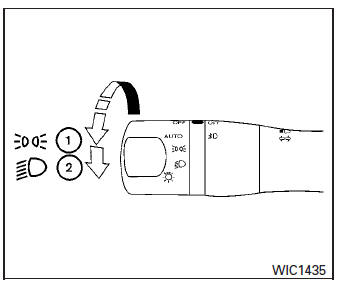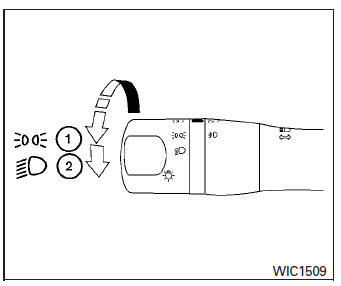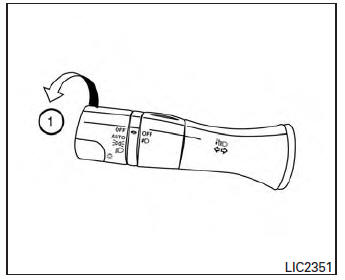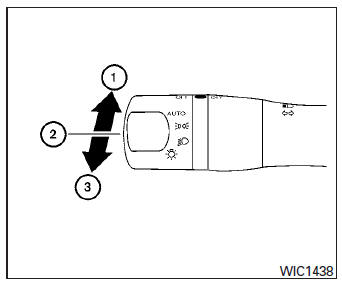Nissan Sentra Owners Manual: Headlight control switch

Type A

Type B
Lighting
- When turning the switch to the
 position,
position,
the front parking, tail, license plate and instrument panel lights come on. - When turning the switch to the
 position,
position,
the headlights come on and all the other lights remain on.
Headlight Type B is equipped with front LED accent lights.

Type C
CAUTION
Use the headlights with the engine running to avoid discharging the vehicle battery.

Type D
Autolight system (if so equipped)
The autolight system allows the headlights to be set so they turn on and off automatically. The autolight system can:
- Turn on the headlights, front parking, tail, license plate and instrument panel lights automatically when it is dark.
- The autolight system will turn on if the windshield wipers make four continuous passes (USA only).
- Turn off all the lights when it is light.

- Keep all the lights on a period of time after you turn the key to OFF and all doors are closed.
To turn on the autolight system:
- Turn the headlight switch to the AUTO position 1 .
- Turn the ignition key to ON.
- The autolight system automatically turns the headlights on and off.
Initially, if the ignition switch is turned OFF and a door is opened and left open, the headlights remain ON for a period of time. If another door is opened while the headlights are on, then the timer is reset.
To turn the autolight system off, turn the switch to
the OFF,  , or
, or
 position.
position.
Be sure you do not put anything on top of the autolight sensor located in the top side of the instrument panel. The autolight sensor controls the autolight; if it is covered, the autolight sensor reacts as if it is dark out and the headlights will illuminate. If this occurs while parked with the engine off and the key in the ON position, your vehicle’s battery could become discharged.
Headlight beam select

- To select the high beam function, push the
lever forward. The high beam lights come on
and the
 light illuminates.
light illuminates. - Pull the lever back to select the low beam.
- Pulling and releasing the lever flashes the headlight high beams on and off.
Battery saver system
If the ignition switch is placed in the OFF position
while the headlight switch is in the 
or  position, the headlights will
position, the headlights will
turn off after
a period of time.
| WARNING When the daytime running light system is active, tail lights on your vehicle are not on. It is necessary at dusk to turn on your headlights. Failure to do so could cause an accident injuring yourself and others. |
 Instrument brightness control
Instrument brightness control
Push the “+” button A to increase the brightness
of instrument panel lights when driving at
night.
Push the “-” button B to decrease the brightness
of instrument panel lights when dr ...
Other materials:
P2858 Clutch B Pressure
DTC Logic
DTC
CONSULT screen terms
(Trouble diagnosis content)
DTC detection condition
Possible causes
P2858
CLUTCH B PRESSURE
(Clutch B Pressure Engagement
Performance)
The auxiliary gearbox gear ratio is 2.232 or
more for the auxiliary gearbox 2GR ratio ...
Wiring diagram
Tire pressure monitoring system
With intelligent key
WITH INTELLIGENT KEY : Wiring Diagram
Without intelligent key
WITHOUT INTELLIGENT KEY : Wiring Diagram
...
Unit disassembly and assembly
Center console assembly
Exploded View
Center console upper finisher
Center console side finisher (RH)
Center console side finisher (LH)
Center console side finisher screw cover
(LH/RH)
Center console assembly
Center console screw cover (LH/RH)
Center console rear finisher
C ...

